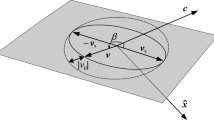Abstract
A stabilization of the classical equations of two-body motion is offered. It is characterized by the use of the regularizing independent variable (eccentric anomaly) and by the addition of a control-term to the differential equations. This method is related to the KS-theory (Stiefel, 1970) which performed for the first time a stabilization of the Kepler motion. But in contrast to the KS-theory our method does not transform the coordinates of the particle. As far as the theory of stability and the numerical experiments are concerned we restrict ourselves to thepure Kepler motion. But, of course, the stabilizing devices will also improve the accuracy of the computation of perturbed orbits. We list, therefore, also the equations of the perturbed motion.
Similar content being viewed by others
References
Stiefel, E. L. and Scheifele, G.: 1971,Linear and Regular Celestial Mechanics, Springer-Verlag Berlin, Heidelberg, New York.
Stiefel, E. L.: 1970,Celest. Mech. 2, 274–281.
Szebehely, V.: 1967,Theory of Orbits, Academic Press, New York.
Author information
Authors and Affiliations
Rights and permissions
About this article
Cite this article
Baumgarte, J. Numerical stabilization of the differential equations of Keplerian motion. Celestial Mechanics 5, 490–501 (1972). https://doi.org/10.1007/BF01464775
Received:
Issue Date:
DOI: https://doi.org/10.1007/BF01464775




